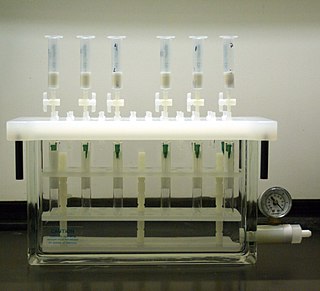Chromatography is a laboratory technique for the separation of a mixture. The mixture is dissolved in a fluid called the mobile phase, which carries it through a system on which is fixed a material called the stationary phase. The different constituents of the mixture have different affinities for the stationary phase. The different molecules stay longer or shorter on the stationary phase, depending on their interactions with its surface sites. So, they travel at different apparent velocities in the mobile fluid, causing them to separate. The separation is based on the differential partitioning between the mobile and the stationary phases. Subtle differences in a compound's partition coefficient result in differential retention on the stationary phase and thus affect the separation.

High-performance liquid chromatography (HPLC), formerly referred to as high-pressure liquid chromatography, is a technique in analytical chemistry used to separate, identify, and quantify each component in a mixture. It relies on pumps to pass a pressurized liquid solvent containing the sample mixture through a column filled with a solid adsorbent material. Each component in the sample interacts slightly differently with the adsorbent material, causing different flow rates for the different components and leading to the separation of the components as they flow out of the column.

Ethyl carbamate (also called urethane) is an organic compound with the formula CH3CH2OC(O)NH2. It is an ester of carbamic acid and a white solid. Despite its name, it is not a component of polyurethanes. Because it is a carcinogen, it is little used, but it naturally forms in low quantities in many types of fermented foods and drinks.

Solid-phase extraction (SPE) is an extractive technique by which compounds that are dissolved or suspended in a liquid mixture are separated from other compounds in the mixture according to their physical and chemical properties. Analytical laboratories use solid phase extraction to concentrate and purify samples for analysis. Solid phase extraction can be used to isolate analytes of interest from a wide variety of matrices, including urine, blood, water, beverages, soil, and animal tissue.
Electroextraction (EE) is a sample enrichment technique that focuses charged analytes from a large volume of one phase into a small volume of aqueous phase through the application of an electric current. The technique was originally developed as a separation technique for chemical engineering, but has since been coupled to capillary electrophoresis and liquid chromatography–mass spectrometry as a means of improving limits of detection, analysis time, and selectivity. The use of EE-CE has made capillary electrophoresis more applicable to use in the pharmaceutical industry.

Tangeretin is an O-polymethoxylated flavone that is found in tangerine and other citrus peels. Tangeretin strengthens the cell wall and acts as a plant's defensive mechanism against disease-causing pathogens.

Gallocatechol or gallocatechin (GC) is a flavan-3-ol, a type of chemical compound including catechin, with the gallate residue being in an isomeric trans position.

JWH-307 is an analgesic drug used in scientific research, which acts as a cannabinoid agonist at both the CB1 and CB2 receptors. It is somewhat selective for the CB2 subtype, with a Ki of 7.7 nM at CB1 vs 3.3 nM at CB2. It was discovered by, and named after, John W. Huffman. JWH-307 was detected as an ingredient in synthetic cannabis smoking blends in 2012, initially in Germany.
The history of chromatography spans from the mid-19th century to the 21st. Chromatography, literally "color writing", was used—and named— in the first decade of the 20th century, primarily for the separation of plant pigments such as chlorophyll and carotenoids. New forms of chromatography developed in the 1930s and 1940s made the technique useful for a wide range of separation processes and chemical analysis tasks, especially in biochemistry.
Partition chromatography theory and practice was introduced through the work and publications of Archer Martin and Richard Laurence Millington Synge during the 1940s. The process of separating mixtures of chemical compounds by passing them through a column that contains a solid stationary phase that was eluted with a mobile phase was well known at that time. Chromatographic separation was considered to occur by an adsorption process whereby compounds adhered to a solid media and were washed off the column with a solvent, mixture of solvents, or solvent gradient. In contrast, Martin and Synge developed and described a chromatographic separation process whereby compounds were partitioned between two liquid phases similar to the separatory funnel liquid-liquid separation dynamic. This was an important departure, both in theory and in practice, from adsorption chromatography.
Bioanalysis is a sub-discipline of analytical chemistry covering the quantitative measurement of xenobiotics and biotics in biological systems.
Prodelphinidin is a name for the polymeric tannins composed of gallocatechin. It yields delphinidin during depolymerisation under oxidative conditions.

Prodelphinidin B3 is a prodelphinidin dimer found in food products such as barley and beer, in fruits and pod vegetables. It can also be found in pomegranate peels.

ABT-202 is a drug developed by Abbott, which acts as an agonist at neural nicotinic acetylcholine receptors and has been researched for use as an analgesic, although it has not passed clinical trials.

N-Desalkylflurazepam is a benzodiazepine analog and an active metabolite of several other benzodiazepine drugs including flurazepam, flutoprazepam, fludiazepam, midazolam, flutazolam, quazepam, and ethyl loflazepate. It is long-acting, prone to accumulation, and binds unselectively to the various benzodiazepine receptor subtypes. It has been sold as a designer drug from 2016 onward.

Countercurrent chromatography is a form of liquid–liquid chromatography that uses a liquid stationary phase that is held in place by centrifugal force and is used to separate, identify, and quantify the chemical components of a mixture. In its broadest sense, countercurrent chromatography encompasses a collection of related liquid chromatography techniques that employ two immiscible liquid phases without a solid support. The two liquid phases come in contact with each other as at least one phase is pumped through a column, a hollow tube or a series of chambers connected with channels, which contains both phases. The resulting dynamic mixing and settling action allows the components to be separated by their respective solubilities in the two phases. A wide variety of two-phase solvent systems consisting of at least two immiscible liquids may be employed to provide the proper selectivity for the desired separation.
A separation process is a method that converts a mixture or solution of chemical substances into two or more distinct product mixtures. At least one of results of the separation is enriched in one or more of the source mixture's constituents. In some cases, a separation may fully divide the mixture into pure constituents. Separations exploit differences in chemical properties or physical properties between the constituents of a mixture.
Electro membrane extraction, or EME, is a miniaturized liquid-liquid extraction technique developed for sample preparation of aqueous samples prior to analysis by chromatography, electrophoresis, mass spectrometry, and related techniques in analytical chemistry. EME involves the use of a small supported liquid membrane (SLM) sustained in the wall of a porous hollow fiber, and application of an electrical field across the SLM.
Centrifugal partition chromatography is a special chromatographic technique where both stationary and mobile phase are liquid, and the stationary phase is immobilized by a strong centrifugal force. Centrifugal partition chromatography consists of a series-connected network of extraction cells, which operates as elemental extractors, and the efficiency is guaranteed by the cascade.

Thiophanate-methyl is an organic compound with the formula C6H4(NHC(S)NH(CO)OCH3)2. The compound is a colorless or white solid, although commercial samples are generally tan-colored. It is prepared from o-phenylenediamine.











